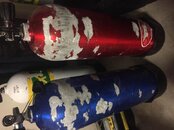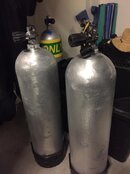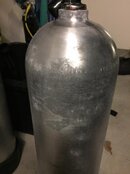Leadking
Contributor
Be careful, NEVER use a paint or system that requires heat. Any good shop will be very cautious around any repainted aluminum tank.
Welcome to ScubaBoard, the world's largest scuba diving community. Registration is not required to read the forums, but we encourage you to join. Joining has its benefits and enables you to participate in the discussions.
Benefits of registering include
It's already been mentioned to use chemical aircraft stripper, which will certainly work, but for me it's not practical because the stripper costs money, and I already have air power, a good air orbital sander, and lots of sand paper around.I know this is an oldish post, but does anyone have a protocol/suggestions for stripping the paint off an AL tank?

Open aluminum will corrode less than painted aluminum simply because the metal can breathe and dry out.Ok, bringing this up again (better than an new thread, right?) It's been almost a year since the last question, but moving, new job, less diving has made this a low priority. Here are the tanks with chipping paint. I like the suggestions above to sand off the paint. Do I need to polish or "finish" the tank to ensure it is safe from rust/corrosion? I'm worried about function over aesthetics. Want to do this before I re-VIP the tanks.
I tried using a steel scrub brush on the open spaces, and it made a fine powder that might be just deposited salt, or maybe aluminum? Perhaps that was a bad idea?
Catalina AL80 tanks, btw.
View attachment 220277


